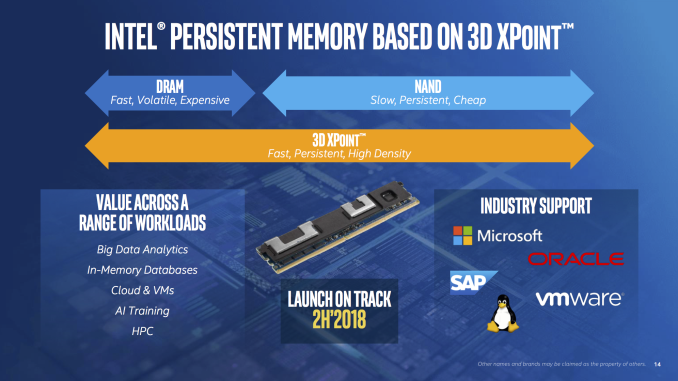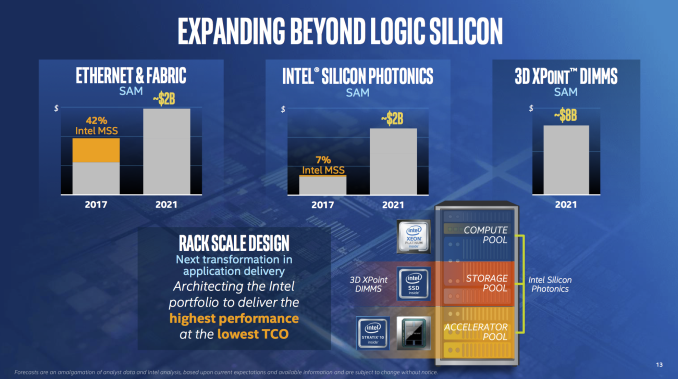Intel To Launch 3D XPoint DIMMs in 2H 2018
by Billy Tallis on November 14, 2017 6:20 PM EST
Presenting at the UBS Global Technology Conference today, Navin Shenoy, Intel Executive Vice President and General Manager of their Data Center Group, shared an update on Intel's roadmap for 3D XPoint DIMMs. Intel claims that they are on track to launch 3D XPoint memory modules in the second half of 2018. They are projecting that 3D XPoint DIMMs will be an $8B market by 2021.
After launching several Optane SSD products this year based on 3D XPoint memory, Intel had said almost nothing about their progress toward 3D XPoint DIMM memory modules. Intel first publicly showed a prototype 3D XPoint NVDIMM in January 2016, only a few months after unveiling 3D XPoint memory itself. When the first Optane products launched earlier this year, we were told Intel would have more to say on the subject of 3D XPoint DIMMs in 2018, but today's announcement makes it clear they will be selling the actual hardware within about a year.
The launch of 3D XPoint DIMMs will depend on several pieces coming together. First, Intel's 3D XPoint memory must be sufficiently mature to meet the performance and endurance requirements of DIMM-based usage. Their Optane SSDs have all used a PCIe and NVMe interface that adds substantial latency overhead and makes it difficult to assess how close the underlying 3D XPoint memory can come to DRAM performance levels. The Optane SSDs are also shipping with relatively conservative write endurance ratings relative to the eventual expectations for 3D XPoint products: The Optane SSD DC P4800X's 30 drive writes per day for 5 years is not significantly higher than high-endurance flash-based enterprise SSDs can provide.
Second, Intel will need to continue increasing production of 3D XPoint memory as their family of Optane SSDs expands and is joined by 3D XPoint DIMMs. Yesterday, Intel and Micron celebrated the completion of an expansion to building 60 of their IM Flash production facilities in Lehi, Utah. This will significantly increase their production capacity of 3D XPoint memory. So far, Intel seems to have been using almost all of the production of 3D XPoint memory for their Optane products while Micron has yet to publicly introduce any mass-produced 3D XPoint-based products. Micron will most likely start announcing and shipping 3D XPoint products under their QuantX brand within the next year, so Intel won't be getting the full benefit of this capacity boost.
Third, 3D XPoint DIMMs will require server platform support because they are unlikely to operate as standard DDR4 DIMMs. The JEDEC NVDIMM-P standard for persistent memory DIMMs has not been finalized and is expected next year. It's not certain whether the 3D XPoint DIMMs will adhere to the NVDIMM-P standard or if they will use a proprietary interface, but either way they are likely to require updated CPU and motherboard support. Intel's recently-launched Xeon Scalable platform can support DRAM+flash NVDIMM-N modules. The launch next year of 3D XPoint DIMMs may foretell a simultaneous refresh of the Xeon Scalable platform.
Source: Intel











58 Comments
View All Comments
ironargonaut - Thursday, November 16, 2017 - link
"frustration"? Your reading comprehension inadequacy is only surpassed by your ability to create strawmen. My dog can lick his balls also, that doesn't make him superior to me.ironargonaut - Thursday, November 16, 2017 - link
Seriously though, at one point I thought you might provide interesting technical contradictory points, and then I would read others responses to try and determine if validity one way or the other. But, now all it is snide comments mostly not relevant to any serious discussion and when someone makes a technical rebuttal all you do is ad hominem attacks and deflection. I don't want to argue w/you because that is pointless, I just want to block your comments so I can read the serious ones.ddrіver - Saturday, November 18, 2017 - link
Great that nobody cares about what you want then.iwod - Wednesday, November 15, 2017 - link
Does it work with Any DIMM? Like with EPYC or ARM64 processors?Dmcq - Wednesday, November 15, 2017 - link
I believe everyone with an interest in servers has been putting support for persistent memory into their processors. Not all that much is required but it is like he problem in systems to ensure a flush really does put data somewhere that would survive a power failure rather than some cache that gets lost. There is a tension there that as often gone for speed rather than safety.tsk2k - Wednesday, November 15, 2017 - link
Okay, but do I need this in my gaming rig?Dmcq - Wednesday, November 15, 2017 - link
No, but I can definitely see it being used in smartphones.PeachNCream - Wednesday, November 15, 2017 - link
Oooh that would be a great place for Optane to go!Dmcq - Wednesday, November 15, 2017 - link
Optane is the SSD version. That would be too slow for instant on for smartphones.Intel do sell Optane for gaming and it is fine for that purpose.
Dmcq - Wednesday, November 15, 2017 - link
The point is that it would be possible to cut down the power requirements for a smartphone whilst making it look like it has a larger memory. You'd want to only read or write as necessary when starting up or closing down and keep as little memory as possible powered up in between uses.